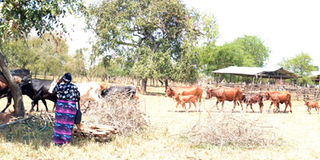Cattle keepers suffer losses over dry spell in Nakasongola

Cattle grazing at a farm in Nakitoma Subcounty, Nakasongola District. PHOTO | DAN WANDERA
What you need to know:
- Statistics show that 70 percent of the district population are cattle keepers who entirely depend on seasonal rains to feed their animals.
Dry spells that have hit parts of Nakasongola District since last October have caused a drop in cattle prices with a cow costing between Shs200,000 and Shs350,000.
Water sources and pastures have been depleted, causing starvation and death of many cows.
The most affected areas are Kabuye, Nabiswera, Kimaga, Lwampanga, and Nakitoma sub-counties.
Livestock farmers in Nabiswera, where more than 20 cows have died, claim that the long distances that the animals are forced to move in search of water and pasture contributes to the starvation and death of some.
“The land in parts of Nakasongola has been left bear with animals left to eat the dry shrubs. When these animals are driven for long distances in search of water, many get tired and collapse. If a farmer is lucky, the animal can be bought off before it dies at a negotiable fee that might not be above Shs350,000,” Mr Yosam Rugundana, a livestock farmer in Nabiswera, said last week.
While some few parts of the central region have begun experiencing some scattered rains, many parts of Nakasongola are still very dry.
“We fear that once the dry spell extends to the end of the month of March, the losses will be higher,” Mr Jonathan Akweteireho, the deputy resident district commissioner, said.
Mr Sam Kasozi, the chairperson of Nakasongola Cattle Traders Association, concurs with Mr Akweteireho.
“I feel very sorry for our farmers that are struggling to feed their livestock. As traders, we equally fail to market a cow that has lost weight and is in bad shape after starving for some time. It is true that a farmer will be forced to give away a cow that would have fetched Shs1.8 million at Shs300, 000 when the animal collapses,” he said.
The district production department is yet to ascertain the exact number of animals lost as a result of the prolonged dry spell.
However, the district chairperson, Mr Sam Kigula, estimates that more than 100 animals have died.
“We pray that the rains come to Nakasongola soon,” Mr Kigula said.
Statistics show that 70 percent of the district population are cattle keepers who entirely depend on seasonal rains to feed their animals.
The district has about 260,000 head of cattle with Nakitoma and Nabiswera sub-counties having the highest number. In many parts of the district, residents walk long distances in search of water and others stand in long queues at boreholes.
In 2014, the Ministry of Agriculture rolled out a programme meant to enable the cattle corridor areas of Nakasongola, Luweero, and Nakaseke get excavators to construct more valley dams.
The excavators, which would be shared with Nakaseke, Luweero and Nakasongola on a rotational basis, according to Nakasongola officials, was withdrawn under unclear circumstances.





